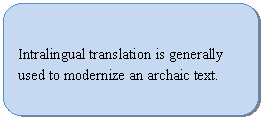| |
Intralingual translation
What would prompt us to translate within one particular language system? The only  situation in which we would do this is when our own language seems unintelligible to us. This happens when the text is an ancient one, and the language used is an archaic form of the one which we are currently using. In English, the text of Geoffrey Chaucer is a good example. Chaucer wrote in what is now called Middle English which is practically another language to the speaker of English today. The first lines of the Prologue to his famous The Canterbury Tales are: situation in which we would do this is when our own language seems unintelligible to us. This happens when the text is an ancient one, and the language used is an archaic form of the one which we are currently using. In English, the text of Geoffrey Chaucer is a good example. Chaucer wrote in what is now called Middle English which is practically another language to the speaker of English today. The first lines of the Prologue to his famous The Canterbury Tales are:
“Whan that Aprill, with his shoures soote
The droghte of March hath perced to the roote”
Now this is not as unintelligible as a foreign language, but is difficult to understand and needs to be explained / translated into modern English idiom for a contemporary reader. “When April with his sweet showers / Has pierced the drought of March to the roots” – this explanation is in the same language and so it cannot be really called translation in the way we would term the transference of an English text into French. What is done here is intralingual translation. Chaucer’s archaic language has been made contemporary.
This modernization of idiom is necessary for most languages, as they tend to evolve over time. Chaucer’s Middle English was different in spelling and grammar, and so technically can be described as a foreign language. Even if there are no major differences like these, the nature of idiomatic language changes so much that much of it will appear very unfamiliar at a later stage. This will require translation. For example, Shakespeare writes in basically the same English that is used nowadays, but there are obstacles to perfect comprehension because of differences in usage. The ‘thou’ and ‘thee’ of Shakespeare are the most obvious examples. Besides these, many of the words he used had meanings that were different from the ones that we have today. For example, when Portia remarks, “So shines a good deed in a naughty world” in The Merchant of Venice, the modern reader might be a bit puzzled. “Naughty” is an adjective that today we reserve for children and indicates a form of hyperactivity that we treat with indulgence. However, in Shakespeare’s time this word was used in the sense of evil or wicked. If this meaning is not known to the reader, Portia’s speech would not make much sense. For the meaning to be clear, we need something like a translation.
It is for precisely this reason that Charles Lamb, along with his sister, wrote Tales from Shakespeare. Lamb rewrote the stories of Shakespeare’s plays in contemporary idiomatic English so that children could follow the gist of the plays. This was not exactly termed translation, but an adaptation of Shakespeare. There have been countless versions like these of classics, epics etc which were meant for children. Shouldn’t we be thinking of them as intralingual translations?
|